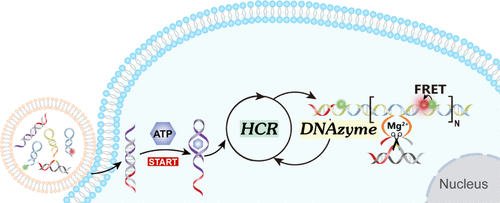当前位置:
X-MOL 学术
›
ACS Appl. Mater. Interfaces
›
论文详情
Our official English website, www.x-mol.net, welcomes your
feedback! (Note: you will need to create a separate account there.)
Enzyme-Free Autocatalysis-Driven Feedback DNA Circuits for Amplified Aptasensing of Living Cells
ACS Applied Materials & Interfaces ( IF 8.3 ) Pub Date : 2022-01-19 , DOI: 10.1021/acsami.1c22767 Yuhui Gao 1 , Yingying Chen 1 , Jinhua Shang 1 , Shanshan Yu 1 , Shizhen He 1 , Ran Cui 1 , Fuan Wang 1
ACS Applied Materials & Interfaces ( IF 8.3 ) Pub Date : 2022-01-19 , DOI: 10.1021/acsami.1c22767 Yuhui Gao 1 , Yingying Chen 1 , Jinhua Shang 1 , Shanshan Yu 1 , Shizhen He 1 , Ran Cui 1 , Fuan Wang 1
Affiliation

|
Aptasensors with high specificity have emerged as powerful tools for understanding various biological processes, thus providing tremendous opportunities for clinical diagnosis and prognosis. However, their applications in intracellular molecular imaging are largely impeded due to the low anti-interference capacity in biological environments and the moderate sensitivity to targets. Herein, a robust enzyme-free autocatalysis-driven feedback DNA circuit is devised for amplified aptasensing, for example, adenosine triphosphate (ATP) and thrombin, with a significantly improved sensitivity in living cells. This initiator-replicated hybridization chain reaction (ID-HCR) circuit was acquired by integrating the HCR circuit with the DNAzyme biocatalysis. Also, the autocatalysis-driven aptasensor consists of a recognition element and an amplification element. The recognition unit can specifically identify ATP or thrombin via a versatile conformational transformation, resulting in the exposure of the initiator to the autocatalysis-driven circuit. The ID-HCR element integrates the charming self-assembly characteristics of the HCR and the remarkable catalytic cleavage capacity of DNAzyme for realizing the continuously self-sustained regeneration or replication of trigger strands and for achieving an exponential signal gain. The autocatalysis-driven aptasensor has been validated for quantitative analysis of ATP and thrombin in vitro and for monitoring the corresponding aptamer substrates with various expressions in live cells. More importantly, the autocatalysis-driven aptasensor, as a versatile amplification strategy, holds enormous potential for analysis of other less abundant biomarkers by changing only the recognition element of the system.
中文翻译:

无酶自催化驱动的反馈 DNA 电路,用于放大活细胞的适感
具有高特异性的适体传感器已成为了解各种生物过程的有力工具,从而为临床诊断和预后提供了巨大的机会。然而,由于在生物环境中的抗干扰能力低以及对靶标的敏感性中等,它们在细胞内分子成像中的应用在很大程度上受到了阻碍。在此,设计了一种强大的无酶自催化驱动的反馈 DNA 电路,用于放大适体感应,例如三磷酸腺苷 (ATP) 和凝血酶,在活细胞中具有显着提高的敏感性。通过将 HCR 电路与 DNAzyme 生物催化相结合,获得了这种引发剂复制的杂交链式反应 (ID-HCR) 电路。此外,自催化驱动适体传感器由识别元件和放大元件组成。识别单元可以通过通用的构象转换特异性识别 ATP 或凝血酶,从而使引发剂暴露于自催化驱动的电路中。ID-HCR元件融合了HCR迷人的自组装特性和DNAzyme显着的催化裂解能力,可实现触发链的持续自我持续再生或复制,实现指数信号增益。自催化驱动的适体传感器已被验证用于体外 ATP 和凝血酶的定量分析,并用于监测活细胞中具有各种表达的相应适体底物。更重要的是,自催化驱动的适体传感器,作为一种通用的放大策略,
更新日期:2022-02-02
中文翻译:

无酶自催化驱动的反馈 DNA 电路,用于放大活细胞的适感
具有高特异性的适体传感器已成为了解各种生物过程的有力工具,从而为临床诊断和预后提供了巨大的机会。然而,由于在生物环境中的抗干扰能力低以及对靶标的敏感性中等,它们在细胞内分子成像中的应用在很大程度上受到了阻碍。在此,设计了一种强大的无酶自催化驱动的反馈 DNA 电路,用于放大适体感应,例如三磷酸腺苷 (ATP) 和凝血酶,在活细胞中具有显着提高的敏感性。通过将 HCR 电路与 DNAzyme 生物催化相结合,获得了这种引发剂复制的杂交链式反应 (ID-HCR) 电路。此外,自催化驱动适体传感器由识别元件和放大元件组成。识别单元可以通过通用的构象转换特异性识别 ATP 或凝血酶,从而使引发剂暴露于自催化驱动的电路中。ID-HCR元件融合了HCR迷人的自组装特性和DNAzyme显着的催化裂解能力,可实现触发链的持续自我持续再生或复制,实现指数信号增益。自催化驱动的适体传感器已被验证用于体外 ATP 和凝血酶的定量分析,并用于监测活细胞中具有各种表达的相应适体底物。更重要的是,自催化驱动的适体传感器,作为一种通用的放大策略,















































 京公网安备 11010802027423号
京公网安备 11010802027423号